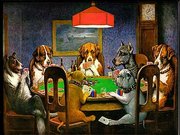The Simulacrumists
From Plastic Tub
| The Simulacrumists (alias The Copiests, The Vanillists and sometimes the Denaturists) were a collective of ad-men, writers and publishing houses funded by heavy-handed capitalists intent on smashing counter-ideologies in the name of deregulation and free markets. The artisans were instructed to amass a campaign of mediocrity and to ensure group-think through the dilution of opposing ideals. The Copiests, as they were commonly called, were the extension of the movement that worked exclusively in the art world, attacking newer art forms like the ready made, minimalism and the more fringe elements of the conceptual world. The idea was to copy and appropriate style and ideas from up-and-coming movements and quickly release tainted versions into the public consciousness via the mass media.
[edit] ExtrapolationWhitewash The movement began in Paris in 1912 as a Utopian formula with a cockeyed ideology: the belief in higher achievement through homogeneous assimilation of everything from language and attitude to art and architecture. These ideals soon found favor with certain radical publishing groups who would spread the ideology until the First World War caused the movement to fracture and regroup in the United States. Gray Matter Although forgers have long operated in the art world, the methods employed by the Copiests were not as focused on the actual replication of the artworks as much as hijacking the essence of the idea. The movement began with as a covert attempt to bring their message of World War One "Dada ideals" to the States by way of the movement's main magazine Le Mal Jumellent and its controversial editor Heinrich Erickson. At the height of the movement, members scoured the nation lifting ideas from such exotic places as rural flea markets, children's art shows and the senior citizens watercolor circuit. Sunny side down The Simulacrumist goal was twofold: one was to obtain art in its many common and lowly forms as to ensure the direct dissemination of Poob Culture. The second aim was to spread disinformation and prejudice through plagiarism and slander. Many of the eastern European members eventually found themselves stateside working their evil magic on Madison avenue, influencing the entertainment and publishing industries. Freedom Fries The movement was essentially anti-modern and sought to derail any new philosophies that may have led society to a better understanding of the power structures under which they find themselves constantly struggling. Malcom Aaronson of Media This explains:
The real reasons behind the counterfeit ring was not to make money but to stifle and poison societies acceptance of the creative arts. Their goal was to emasculate any progressive movements which may have influenced the general public by co-opting lower art forms and producing them on such a mass scale so as to confuse and corrupt the markets, and supplant the high with the low, the Canon with the Kitsch. It is a commonly-known fact that most sympathizers of the movement work in Hollywood, primarily in the sit-com sector. Their masterworks include the painting of the old ship captain, the painting of the dead tree with yellow sky and most famously the painting of dogs playing poker. [edit] See Also |

